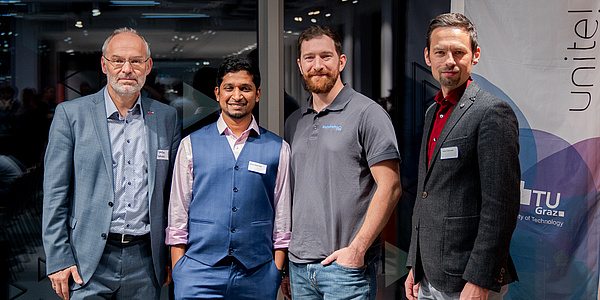What is Concrete?
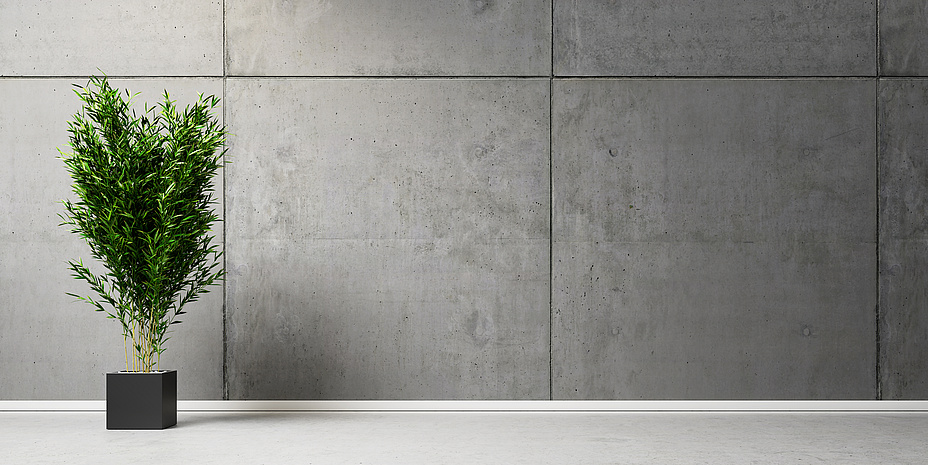
“It’s best if you come to my lecture – concrete is such a broad field,” says a laughing Markus Krüger, head of the Institute of Technology and Testing of Construction Materials at Graz University of Technology (TU Graz). Because the question as to what concrete actually is, is incredibly difficult to answer. “Concrete is first and foremost a mass building material that has excellent properties and allows us to construct things as we have conceived them and as would not be possible with any other building material.”
Rock, cement and water
But let’s start from the beginning. Concrete is a hardening mixture of rock of different grain sizes, cement and water. It is mixed to a viscous consistency and poured into the formwork to achieve the desired shape as so-called fresh concrete in most cases. The latest technologies also use robotic arms with print nozzles to 3D print concrete parts freely, i.e. without formwork.
Play video
The concrete printer at TU Graz in action.
In any case, it is important to find the optimum formulation for the required concrete – visually attractive for fair-faced concrete, particularly robust for infrastructure buildings, or already dimensionally stable as fresh concrete to be printed out through a pressure nozzle. These formulations are studied at Markus Krüger’s institute. “Concrete is only a grey, uniform mass at first glance,” he explains. “In reality, concrete is one of the most complex building material that the construction industry has to offer.” Above all, it also works on the optimal composition of the building material in order to achieve higher strengths and longer lifetimes. “In the area of strength, however, we soon reached our limits. Now it is increasingly important to make the material even more sustainable, for example by using fewer of the most climate-damaging components or more environmentally friendly resources in concrete production.”
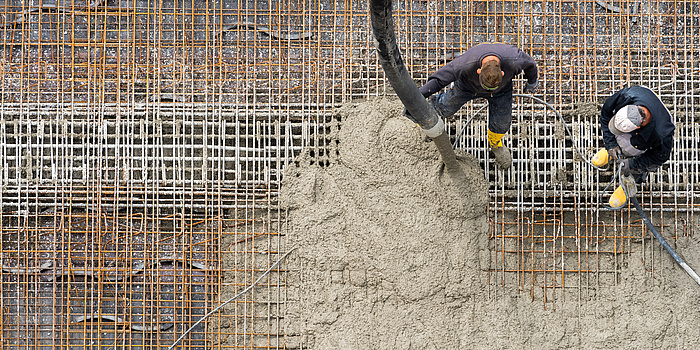
Fresh concrete is brought to the construction site in liquid form and processed directly there. © Kiono, Adobe Stock
The Institute works with waste materials from the construction industry – demolished concrete components are recycled and are thus used as aggregate for new concrete – and from other branches of industry. “For example, we use granulated blast furnace slag from steel production to replace some of the clinker in the cement for decades. But here, too, we will have to look for other alternatives in the future, as granulated blast furnace slag will no longer be available in the required quantities," explains Krüger. Overall, however, the reduction of clinker is a very efficient way of reducing climate-damaging emissions, since the production of cement clinker in particular emits a high level of climate-damaging CO2. But the clinker is responsible for something else. It provides an alkaline environment in the concrete, which in turn protects the steel reinforcement, which is primarily installed in the concrete to transfer tensile forces, from corrosion. “If we reduce the clinker too much, there is a higher risk of steel corrosion, which we then have to counteract by other means. A high degree of complexity if you want to reconcile aspects of durability and ecology and at the same time have to bear in mind that concrete as a mass construction material must still be affordable in the future.”
The team is also working on so-called ultra-high-strength concrete together with colleagues from other TU Graz institutes – concrete that can carry much higher loads and makes much sleeker designs possible. “At first glance, its production is associated with higher CO2 emissions and higher costs, but much less material is needed to achieve the same or better properties than conventional concrete structures,” says Krüger.
Accredited testing and certification body
In addition to working on new concrete formulations, the Institute of Technology and Testing of Construction Materials also operates a accredited testing centre where a multitude of building materials are tested for their suitability for certain areas of application. In addition, building products are certified according to technical regulations, which is essential for their safe use in practice.
Concrete in structures
What is the process from building material to building structure? Among other things, this is what the Institute of Structural Concrete at TU Graz is working on. “Concrete shows complex material behaviour, just as concrete components and structures show demanding load-bearing behaviour,” says Dirk Schlicke, deputy head of the Institute, explaining his research area. “Structures have to bear enormous loads and the high compressive strength of concrete can be used specifically for this purpose.” This is how structures such as high-rise buildings, bridges spanning valleys, dams or tunnels on challenging subsoil become possible in the first place.
In contrast to its high compressive strength, however, concrete has a very low tensile strength – this is counteracted with steel reinforcements. This can be made of reinforcing steel, but also of textile materials based on carbon, polyethylene or alkali-resistant glass. Or, in certain applications, even from small steel or plastic fibres mixed directly into the concrete.
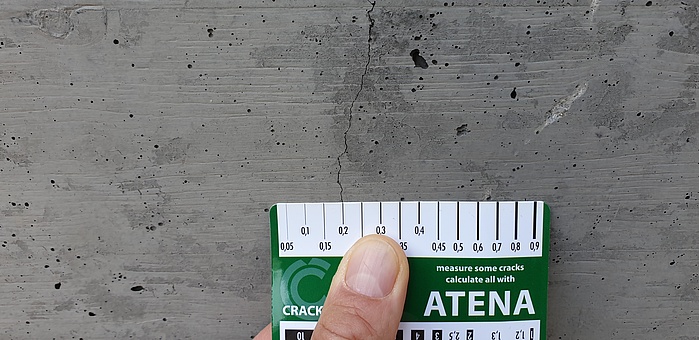
"Cracks are an essential part of concrete construction," explains Dirk Schlicke. © dmitr1ch, Adobe Stock
The interaction of reinforcement and concrete is not trivial, however, as Schlicke explains: “Cracks are an essential part of concrete construction; it is only through the formation of cracks that the reinforcement can participate in load transfer. But not all cracks are intentional.”
Schlicke himself takes a holistic view of the behaviour of concrete in structures – from the initial stress caused by changes in temperature and volume during concrete hardening, via further deformation and load transfer behaviour, and including the question of the extent to which these factors influence the load-bearing capacity of the structure.
Using concrete sensibly
Despite its reputation for not being very environmentally friendly or sustainable, Schlicke is convinced of the sustainability of concrete: “Concrete is a building material that is durable and locally available,” explains Schlicke. Concrete can be produced everywhere on site and thus does not require long and environmentally harmful transport of raw materials. “What is important, however, are the areas where it can be used sensibly,” says Schlicke, alluding to the word “concreting over” that is widely used in the media. There doesn’t have to be concrete everywhere. “Every building material has advantages and in the spirit of resource-responsible building these should be used in a targeted manner. Steel, for example, is powerful and light, wood offers efficient system solutions and brick masonry has great physical properties for residential construction.” Schlicke sees the task of concrete in the future primarily in sustainable construction methods, for example through more efficient use of materials and new construction methods such as modular concrete construction. However, an important task is also the preservation of existing structures that still meet safety standards but for which this cannot be confirmed with inadequate mathematical methods.
One focus that he wants to devote more attention to in the future is where in the planning process researchers and scientists need to get involved in order to be able to implement optimizations in newly built structures. “We’re working with engineering firms here right now that are giving us good insights into where we can tie our developments into practice.”
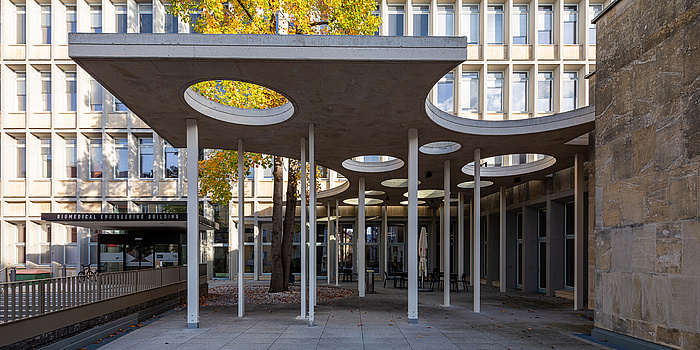
Concrete can be shaped into many different forms. © Markus Kaiser - TU Graz
Urban Mining
And for Markus Krüger, the Institute also has its sights set on an additional research focus: urban mining. This means looking at the building stock in the city of Graz, for example, and predicting future building developments. “Together with colleagues from architecture we want to investigate where buildings will have to be demolished in the next few years, what raw materials or whole components will be released in the process and how we can reuse them in construction.”
Sustainability, recycling and concrete are therefore not contradictory and are increasingly being combined at TU Graz.
This research area is anchored in the Field of Expertise “Sustainable Systems”, one of five strategic foci of TU Graz.
You can find more research news on Planet research. Monthly updates from the world of science at Graz University of Technology are available via the research newsletter TU Graz research monthly.
Kontakt
Markus KRÜGER
Univ.-Prof. Dr.-Ing. Dipl.-Wirtsch.-Ing.
Institute of Technology and Testing of Construction Materials
Inffeldgasse 24 | 8010 Graz
Tel.: +43 316 873 7150
krueger@tugraz.at
Dirk SCHLICKE
Assoc.Prof. Dipl.-Wirtsch.-Ing. Dr. techn.
Institute of Structural Concrete
Lessingstraße 25 | 8010 Graz
Tel.: +43 316 873 6196
dirk.schlicke@tugraz.at


